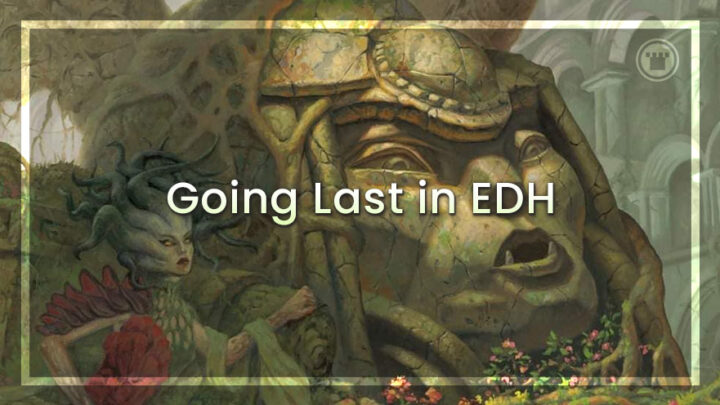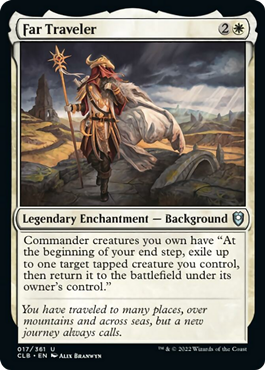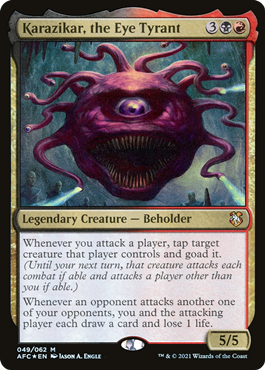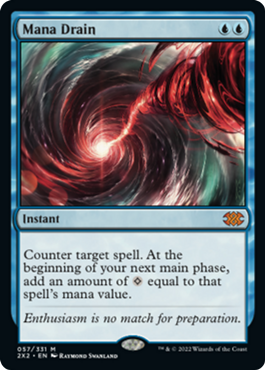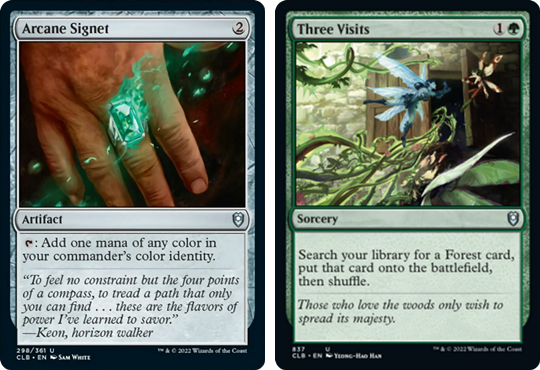Going last in EDH can feel pretty miserable – especially if more than one of your opponents get a speedy start. But just how bad is it to go last? Is it blown out of proportion? Kristen entertains some of the arguments.
Going last in Commander: it’s something we all pray to never happen, and when it happens consecutively, it can feel a little frustrating. Today, I want to dive into some of the arguments for why it sucks and evaluate if they’re fair points to make.
Before I begin, let’s clear something up a little here – I’m speaking from the EDH perspective and not the cEDH perspective. As power levels ramp up, things change, and I’m not enough of an authority on cEDH analysis to say with any confidence whether any particular table position is better than another (other than that going first is just very, very good). What can I say? I have Winota tunnel vision and need to try some other decks.
Also, keep in mind that most – if not all – of these arguments are entirely subjective. Each playgroup is different, and so is each individual, local metagame.
Going last in EDH
Some things never change in EDH. Someone will drop some cards or knock over their deck, someone will go into explicit detail about how they’d have won if they’d only gotten to untap and the player last in turn order will at some point make a joke – or a complaint – about being last.
There’s an undeniable feeling to being in last in casual EDH, and I think it boils down to being reactive rather than proactive. While you might not be making reactive plays, you may still end up in a position of passivity in terms of setting the tempo. The player in first sometimes sets that pace, and sometimes it’ll be the player ahead on mana. Quite often, that ends up being the same person.
Missing a land drop when going last can also feel pretty rough, especially if the game feels aggressive. Being on less mana than anyone else for a good proportion of the game – particularly if your opponents run enough land drops to not miss them as the game goes on – is a recipe for a difficult game. It’s common consensus that the player who curves out and spends the most mana is generally well placed to win any given game of Magic, whether 1v1 or multiplayer.
Critical mass
The player going fourth might feel their ability to reach critical mass is hampered by being last in turn order. That player may be behind on mana and thus play fewer spells through the early and mid-game. Quite regularly, they will be the last player to add to the board before a “Buckaroo” situation ensues.
Players who are wanting to board wipe will wait until a board reaches critical mass, and it’s unfortunately the case that this punishes the player going last more than any other player at the table. While other players might get to at least untap with their creatures for a turn before a wipe happens, the player going last is often caught up in the jostling for position and becomes collateral.
While being hit by a board wipe in this position can feel bad if you’re the furthest behind and the last to recover, it can also feel bad to be the one to play the removal. When you want to be spending your mana on catching up to the other players – by mirroring their ramp or card draw – being in the unenviable position of feeling like you should play the board wipe in your hand instead isn’t great.
Decorum disrupted
Generally speaking, in a game of Casual EDH, there’s a certain civility extended to your fellow players. It’s generally polite to not pile in on the person who is behind when you should be attacking the threat in the mid game. It’s reasonable to let an equipment deck have one Sword of the Animist trigger to let them play the game before you remove it. These are little aspects of sportsmanship that might not apply if you’re playing for keeps.
There’s a threat to that unspoken pretence of peace, though: creatures that trigger when they attack. They keep getting cheaper, they keep getting more powerful and players just can’t do without them — not even for a turn. Whether it’s creatures with amazing attack or combat damage triggers, or equipment or enchantments, there’s a ton of incentive for creature based decks to attack.
Playing blockers is paramount to surviving through chip damage that can often climb to double digits these days. But one thing about going last is you’re likely behind on your sequencing in such a way that when catching up with other players, you’re likely to have fewer good blocks available.
A natural balance to this happening is that players often quickly leave the player behind alone after the pod’s first threat has emerged. If the player in last is truly behind the rest of the pod, then players do tend give them peace for a time.
Sadly, Wizards of the Coast is having none of it, and their current flavor-of-the-week is to print incentives for attacking the player with the most life. While sometimes this does incentivize attacking a player ahead — particularly if their strategy is life gain related — it’s more likely that this will trigger for attacking the player in 4th place who has been given a little breathing space because they’re behind the group.
This can punish them pretty hard, and because EDH players are greedy, the fact that there’s an archenemy at the table will do little to deter the quest for “value.” While these game pieces have been designed with good intent, I think in practice they might not work as intended as often as you’d believe. I recently built Karlach with Sword Coast Sailor. And honestly, my deck just has to jump through that hoop, so someone’s gonna have their day ruined.
Goad can be awkward for the player last in turn order, too. If you have the fewest blockers, you can bet a lot of goaded creatures will be coming at you, especially if the person ahead is doing the goading.
While this is balanced somewhat by each other player being effectively tapped out when it comes back around to you, it can still be frustrating, as you might not even have creatures left if you had to chump block. As I explained in my recent article, I believe Goad is more powerful than people think — and maybe even undercosted on some cards.
While some of the other complaints about going last might be more subjective, there’s one that I can empathize with more readily: being sat to the right of the blue player. Being the last person to play spells before a control player untaps is rough, because in order for them to not give up too much tempo, they will be incentivized to use up any interaction on your turn if nothing rang their alarm bells while your other opponents took a turn. Going last when a blue player is going first is probably the most egregious situation here, as they will Mana Drain you just for “value.” And when that happens while you’re already behind? Yeesh.
Many of these scenarios may feel familiar, but is it because they’re a part of going last in turn order? Or are these just regular issues in EDH that happen when you miss land drops or find yourself behind? Are they maybe issues that are compounded by going last — issues that just happen anyways?
The Sol Ring situation
I’d like to suggest that any disparity felt from going last pales in comparison to being a player at the table without a Sol Ring. And if more than one opponent has an early Sol Ring? That disparity is amplified. I think most of the time, going last in turn order isn’t quite as bad as it’s made out. Instead, it feels that way because of the state of the format. Casual Commander in 2022 is more optimized than it has ever been.
Players have access to a wealth of information from deck building sites, articles and videos. Combined with the very real power creep on new cards and Wizards of the Coast amping up the reprint cycle, we play EDH in a time where it’s never been more accessible to new players.
Hell, despite the fact that they never come with shocklands, newer precons are downright powerful. Undead Unleashed and Buckle Up can jam with casual decks from the past few years right out of the box. And with just a few upgrades, they feel comfortably capable of asserting dominance.
When you consider that an early Sol Ring enables lightning starts when chained into cards like Arcane Signet or Talismans, and that a player can untap with five mana on turn 2, you begin to see how going last can feel so rough.
Acceleration is the aim of the game, more so than ramp. Three Visits and Nature’s Lore reprints has helped bring about this shift just as much as content creation and, in my experiments with a custom ban list on my discord server, we’ve found games that are bereft of cards that go mana positive* are a lot more relaxed and a lot less one sided. While the argument for Sol Ring remains that it injects variance into the game and lets players enjoy the experience of “running hot,” I’m less convinced that it creates a positive experience.
* Mana positive cards that we’ve tested excluding from our more relaxed games include Mana Crypt, Dockside Extortionist, Mana Vault, Sol Ring and Jeska’s Will.
Catch-up mechanics
While I’ve focused mostly on the reasons some players dislike being last in turn order, there are some benefits. Catch-up mechanics are evolving, too, and often it pays to be behind. I’ve been in multiple games recently laughing at the incredulousness of an Archaeomancer’s Map and a Deep Gnome Terramancer bouncing off of each other. While it’s nowhere near as powerful an interaction as the banned Trade Secrets, it was still pretty wild to sit across from.
White is a pretty enjoyable color to be playing with all the new tools, and it’s a color that doesn’t care about being behind. Indeed, decks like Tameshi, Reality Architect revel in being behind on lands.
Factoring in the fact that you should be playing asymmetrical board wipes, and that you should feel justified to run hatebears and stax-lite, there’s no reason why going last should be a death knell. During two of the last five games I won, I was last in turn order, so I don’t see going last in turn order as an insurmountable obstacle.
It’s less going last, more being behind
As I alluded to previously, the issues that players experience when going last are actually just issues felt by players who are behind — whether by missing land drops, being in an awkward tempo spot or having to contend with one or more early, fast mana plays. Being in last place just compounds these issues. Honestly, I think that suboptimal deck building is at least partially responsible.
Going all-in on acceleration and consistency is fine, but if you do, you’re going to have plenty of false starts. So, while the format has veered toward an aggressive drag race, the way to punish those players is to not be afraid of playing more board wipes, more interaction and more speed-bumps.
Nature’s Claim or Broken Bond that Sol Ring – Thieving Skydiver it if you have to. Decks that are all-in run less contingencies and less recursion, so punish them for it. Deflecting Swat and Bolt Bend can’t stop a Blasphemous Act or an Austere Command.
Force your friends back to midrange, mulligan with a little more intent and you’ll find that going last isn’t such a big deal.
Going first is.

Kristen is Card Kingdom’s Head Writer and a member of the Commander Format Panel. Formerly a competitive Pokémon TCG grinder, she has been playing Magic since Shadows Over Innistrad, which in her opinion, was a great set to start with. When she’s not taking names with Equipment and Aggro strategies in Commander, she loves to play any form of Limited.

